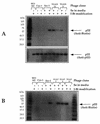The efficiency of Escherichia coli selenocysteine insertion is influenced by the immediate downstream nucleotide
- PMID: 10637327
- PMCID: PMC102542
- DOI: 10.1093/nar/28.3.755
The efficiency of Escherichia coli selenocysteine insertion is influenced by the immediate downstream nucleotide
Abstract
Selenocysteine (Sec) incorporation requires the TGA opal codon and a downstream Sec insertion sequence (SECIS), which can be partially randomized and cloned into M13 pIII fusion constructs for phage display. This combinatorial approach provides a convenient non-radioactive assay that couples phage production to opal suppression. Two SECIS libraries were prepared, with the immediate downstream nucleotide either randomized (TGAN) or fixed as thymidine (TGAT). The TGAN library resulted in a majority of clones with a downstream purine and selenium-independent phage production, implicating the endo-genous tryptophan-inserting opal suppression pathway. Although the addition of sodium selenite to the growth medium did not affect phage production, it did increase the level of Sec insertion, as shown by the chemical reactivity of the resulting phage. The TGAT phage library yielded clones with strictly selenium-dependent phage production and reactivity consistent with the presence of Sec. These clones were prone to spontaneous mutation upon further propagation, however, resulting in loss of the selenium-dependent phenotype. We conclude that the immediate downstream nucleotide determines whether the endogenous opal suppression pathway competes with co-translational Sec insertion.
Figures






References
MeSH terms
Substances
LinkOut - more resources
Full Text Sources
Other Literature Sources

